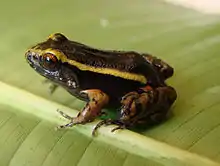Lithodytes
Lithodytes is a genus of frogs in the family Leptodactylidae. It is monotypic, being represented by the single species, Lithodytes lineatus, the gold-striped frog[1] or painted antnest frog.[3] It is found in tropical South America[4] where it lives in humid forests among the leaf litter. These frogs build foam nests at the edge of temporary pools, and the tadpoles develop within these. The frogs also associate with certain leafcutter ants and breed inside their nests without being attacked by the ants.[5]
| Lithodytes | |
|---|---|
 | |
| Scientific classification | |
| Kingdom: | Animalia |
| Phylum: | Chordata |
| Class: | Amphibia |
| Order: | Anura |
| Family: | Leptodactylidae |
| Subfamily: | Leptodactylinae |
| Genus: | Lithodytes Fitzinger, 1843 |
| Species: | L. lineatus |
| Binomial name | |
| Lithodytes lineatus (Schneider, 1799) | |
| Synonyms[2] | |
| |
Description
The female Lithodytes lineatus grows to a length of between 38 and 52 mm (1.5 and 2.0 in), and the male is slightly smaller. It has a slender body and blunt snout. The overall colour is black apart from a pair of yellow lateral stripes running from the snout to the groin, where there is a red or orange patch. The limbs are brown banded with black.[6]
This frog is similar in appearance to the brilliant-thighed poison frog (Allobates femoralis) and may benefit by mimicking the toxic species, as it is avoided by predators.[6]
Distribution and habitat
Lithodytes lineatus is native to tropical South America. Its range includes the Orinoco basin and the Amazon basin and it is present in Colombia, Venezuela, the Guianas, Ecuador, Peru, Bolivia and Brazil. Its natural habitats are subtropical or tropical moist lowland forests, moist savanna, and intermittent freshwater marshes from altitudes ranging from sea level to 1,800 m (5,900 ft) above sea level. The species can be found below logs, among leaf-litter and in other concealed locations on the forest floor.[1]
Ecology
Lithodytes lineatus breeds in temporary pools, building foam nests in which the female lays 100 to 300 eggs. She then guards the developing eggs until the emerging tadpoles hatch.[6]
This frog is often found in association with the leaf-cutter ant Atta cephalotes, with the male frog having been found calling from the interior of an active ants nest, seemingly unattacked by the ants.[6] The ants usually kill intruders into the nest, and the frogs captured at the entrance to the nest had a noticeable aromatic odour; it may be that this acts as a repellent or other chemical signal to the ants. In one instance, four male frogs were calling synchronously from the inside of a large ant nest, the call being a series of brief whistles at the rate of about 85 per minute. Examination of another nest showed various passages and a wide vertical tunnel inside descending to the water table, with foam nests attached to roots in the wall of the tunnel and tadpoles at various stages of development in the underground pool. Ants were also moving along these tunnels. The frogs benefit from this association in that they have a well-protected breeding site and are safe from predation. It is not clear whether the ants benefit from the arrangement, but an examination of the contents of two frogs' stomachs showed that their diet included earthworms, crickets, isopods and insect larvae, with less than 10% being ants.[7] Male frogs of this species have been observed calling at the entrance to, and from inside, an Atta laevigata nest, and juvenile frogs have been observed emerging from a nest of Atta sexdens.[3]
Status
This frog has a very wide distribution and is a common species, and its total population is estimated to be large. It may be in slight decline because of habitat degradation but seems to be able to adapt to secondary habitats. It is also present in a number of protected areas, so the International Union for Conservation of Nature has rated its conservation status as being of "least concern".[1]
References
- La Marca, Enrique; Azevedo-Ramos, Claudia; Coloma, Luis A.; Ron, Santiago & Hardy, Jerry (2010). "Lithodytes lineatus". IUCN Red List of Threatened Species. 2010: e.T57177A11580398. doi:10.2305/IUCN.UK.2010-2.RLTS.T57177A11580398.en.
- Frost, Darrel R. (2020). "Lithodytes lineatus (Schneider, 1799)". Amphibian Species of the World: An Online Reference. Version 6.1. American Museum of Natural History. doi:10.5531/db.vz.0001. Retrieved 28 May 2020.
- Barros, Andre; Lozano, Jorge Luis Lopez; Lima, Albertina (2016). "Lithodytes lineatus (painted antnest frog) association with Atta ants". Herpetological Review. 47 (4): 643.
- Frost, Darrel R. (2020). "Lithodytes Fitzinger, 1843". Amphibian Species of the World: An Online Reference. Version 6.1. American Museum of Natural History. doi:10.5531/db.vz.0001. Retrieved 28 May 2020.
- "Amazonian frog has its own ant repellent". ScienceDaily. 2 October 2016. Retrieved 2 June 2020.
- Halliday, Tim (2016). The Book of Frogs: A Life-Size Guide to Six Hundred Species from Around the World. University of Chicago Press. p. 244. ISBN 978-0-226-18465-4.
- Schlüter, Andreas; Löttker, Petra & Mebe, Konrad (2009). "Use of an active nest of the leaf cutter ant Atta cephalotes (Hymenoptera: Formicidae) as a breeding site of Lithodytes lineatus (Anura: Leptodactylidae)". Herpetology Notes. 2: 101–105.
External links
 Media related to Leptodactylus lineatus at Wikimedia Commons
Media related to Leptodactylus lineatus at Wikimedia Commons Data related to Leptodactylus lineatus at Wikispecies
Data related to Leptodactylus lineatus at Wikispecies
